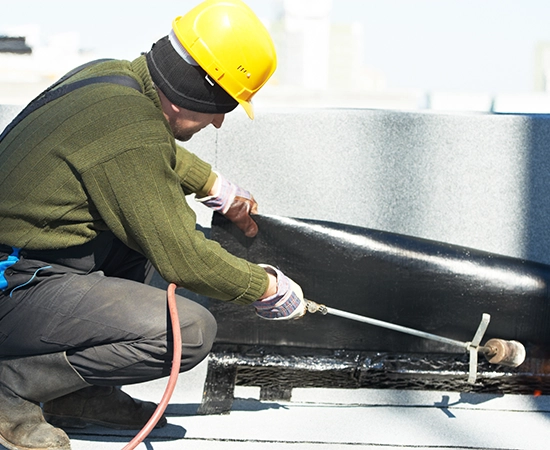When a storm or hurricane strikes, it can leave behind a trail of devastation that extends far beyond the immediate damage caused by high winds and heavy rains. One critical service that plays a crucial role in mitigating further damage is roof tarping. A roof tarping service is an essential step in the aftermath of a storm or hurricane, offering immediate protection for your home while you wait for more permanent repairs. Understanding why roof tarping is so important can help you make informed decisions and take swift action to safeguard your property.
Understanding Roof Tarping
Roof tarping involves placing a heavy-duty tarp over a damaged roof to prevent further exposure to the elements. This temporary measure is designed to provide a barrier against rain, wind, and debris, reducing the risk of additional damage while you arrange for permanent repairs. Roof tarping is not a substitute for long-term roofing solutions but is an essential first step in protecting your home and its contents.
The Immediate Benefits of Roof Tarping
One of the primary reasons roof tarping is essential after a storm or hurricane is its immediate protective benefits. Here are some key advantages:
- Prevents Water Intrusion: The most critical benefit of roof tarping is its ability to prevent water from entering your home. Once your roof is compromised, rainwater can seep through and cause significant damage to your interiors, including ceilings, walls, and floors. A tarp acts as a temporary shield, keeping water out and minimizing the risk of mold and mildew growth.
- Minimizes Structural Damage: Storms and hurricanes can cause significant structural damage to your roof, including missing shingles, holes, and dents. Without a tarp, these issues can worsen over time as more rain and wind exacerbate the damage. A tarp helps to stabilize the situation, reducing the risk of further structural issues and ensuring your home remains safe.
- Protects Belongings: When water seeps through a damaged roof, it can also damage personal belongings such as furniture, electronics, and important documents. By covering your roof with a tarp, you help to safeguard these items from water damage, preserving their condition until more permanent repairs can be made.
Why Timeliness Matters
The timing of roof tarping is crucial for several reasons. The sooner you address roof damage with a tarp, the better the outcome for your home. Here’s why:
- Prevents Additional Damage: The longer you wait to cover a damaged roof, the more time there is for rain and wind to cause further damage. Immediate tarping helps to limit the extent of damage and can save you from costly repairs down the line.
- Reduces Insurance Costs: Many insurance policies cover the cost of emergency measures like roof tarping. By acting quickly and getting a tarp installed, you may be able to reduce your overall repair costs and avoid potential disputes with your insurance provider.
- Speeds Up Permanent Repairs: When you protect your home with a tarp, it becomes easier to focus on arranging for permanent repairs without the added pressure of ongoing damage. A well-maintained tarp ensures that your home remains safe and secure while you wait for professional repairs.
Choosing the Right Roof Tarping Service
Selecting a reliable roof tarping service is essential for effective protection. Here’s what to look for:
- Experience and Expertise: Ensure that the roof tarping service you choose has experience in dealing with storm and hurricane damage. An experienced team will have the knowledge and skills to assess the extent of the damage and install the tarp effectively.
- Quality Materials: The effectiveness of roof tarping depends on the quality of the materials used. Look for a service that uses heavy-duty, weather-resistant tarps to ensure maximum protection for your home.
- Prompt Response: In the aftermath of a storm or hurricane, time is of the essence. Choose a roof tarping service that can respond quickly to your needs and provide timely installation to protect your property.
- Insurance and Licensing: Verify that the roof tarping service is properly licensed and insured. This ensures that you are working with a legitimate provider and that you are protected in case of any accidents or damage during the installation process.
The Role of Roof Tarping in the Larger Repair Process
Roof tarping is just one component of the overall repair process following storm or hurricane damage. Here’s how it fits into the larger picture:
- Assessment and Inspection: After tarping your roof, the next step is to conduct a thorough assessment of the damage. This involves inspecting the roof structure, identifying areas that need repair, and determining the best course of action for permanent repairs.
- Insurance Claims: Documenting the damage and the tarping process is crucial for insurance claims. Make sure to take photos and keep records of all communications with your insurance provider to facilitate the claims process.
- Permanent Repairs: Once the immediate threat is addressed with a tarp, work with a qualified roofing contractor to schedule and complete the necessary repairs. This may involve replacing damaged shingles, fixing leaks, or addressing any structural issues identified during the assessment.
Conclusion
Roof tarping is an essential step in the aftermath of storm or hurricane damage, providing immediate protection for your home and its contents while you arrange for permanent repairs. By preventing water intrusion, minimizing structural damage, and protecting your belongings, roof tarping helps to safeguard your property and reduce the risk of further issues. Choosing a reliable roof tarping service and acting quickly can make a significant difference in the outcome of your repair process. For more information on roof tarping services, visit Full Service Pros, where we offer expert assistance to ensure your home remains safe and secure during challenging times.
Here you can find more Articles



